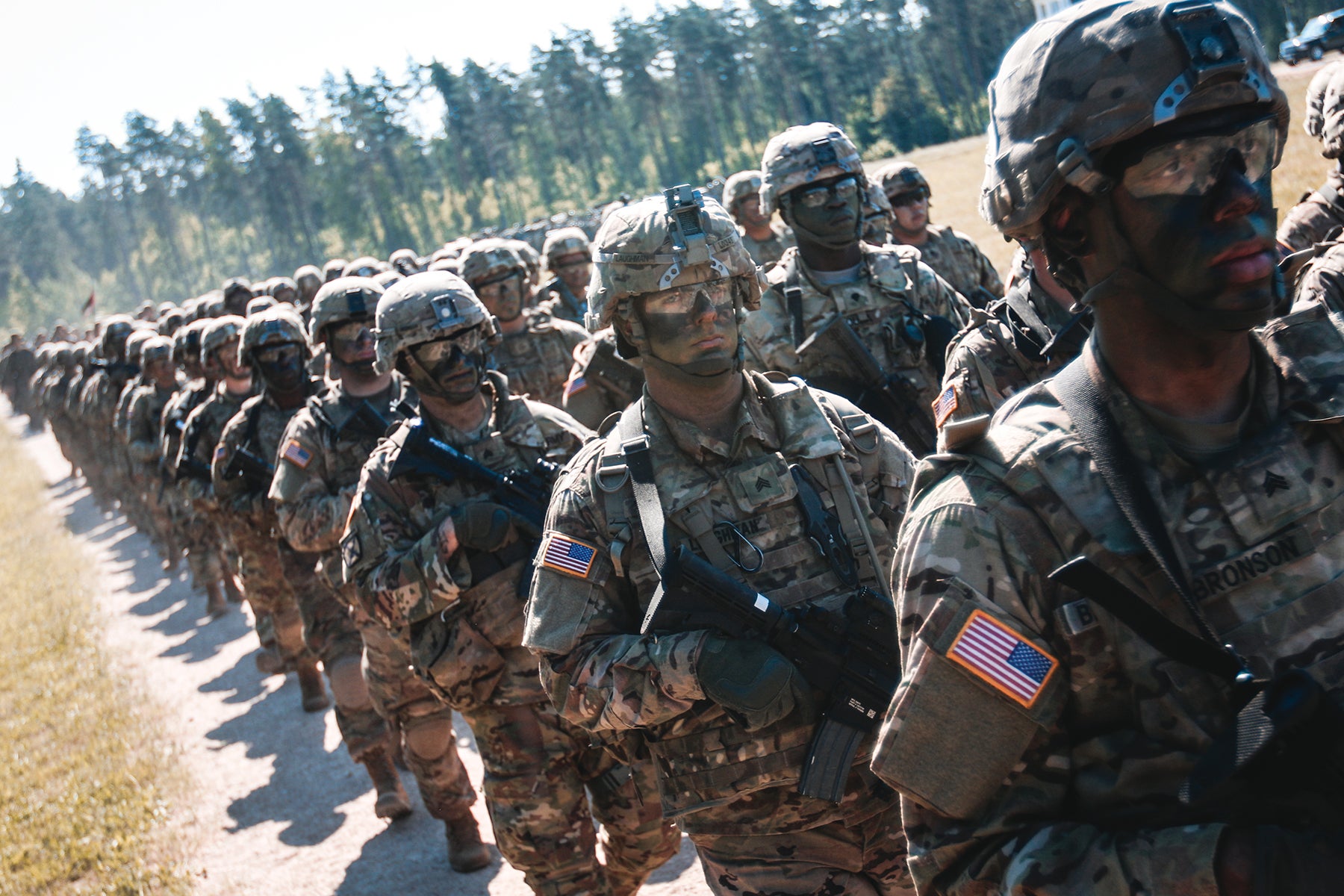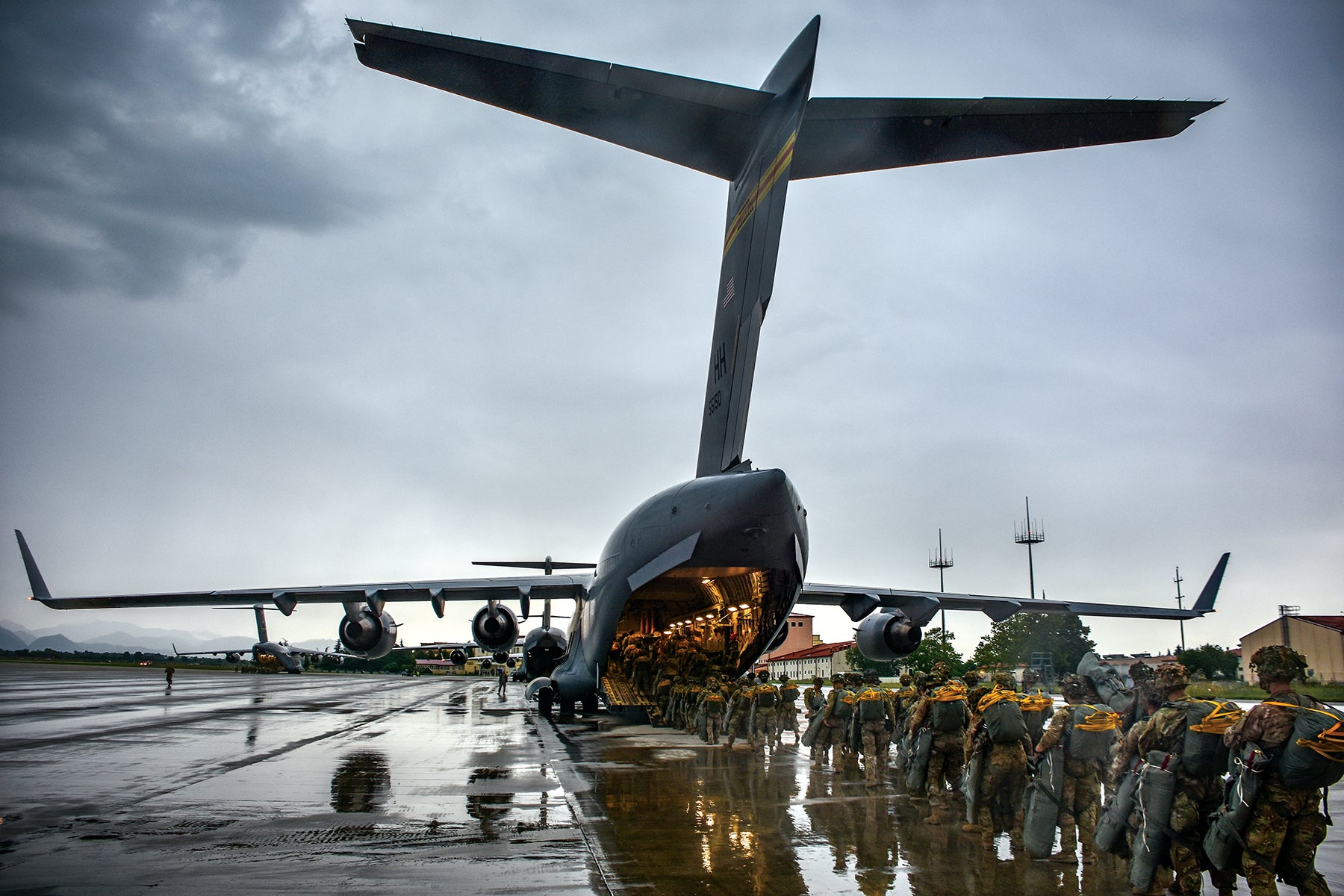In discussing the Army’s mission, Secretary of the Army Mark T. Esper said, “We are a team that plays away games, which means you have to be able to deploy.” This ability to deploy is key to the Army’s mission.
Each service brings an important component to the joint fight. The Navy enables the U.S. to project power in the maritime domain while the Air Force provides unparalleled dominance in the sky. The soldier enables the nation to dominate on land. Formations of soldiers, working as finely honed teams, provide the joint force with the ability to occupy territory and achieve the United States’ toughest strategic objectives, and professional soldiers represent a critical capability within the nation’s military. Congress directs how many soldiers are authorized across the Regular Army, the U.S. Army Reserve and the Army National Guard. Army leadership then must determine how to organize soldiers into formations capable of meeting strategic requirements.
The relationship between the number of Army soldiers (end strength) and the formations required (structure) necessitates a delicate balance. Another way to look at the relationship between end strength and structure is that of supply and demand. Structure is the demand and end strength is the supply. Ideally, there would be just enough soldiers in the right MOS (supply) and grade to match authorizations (demand) for every unit and organization.
But history tells us this is almost never the case.
We also know tension between the numbers of soldiers versus demand is exacerbated during fluctuations in end strength. Over the past dozen years, the Army has undergone a major period of growth, followed by significant reductions and now, another period of growth. These fluctuations have left it struggling to fill units with the right soldiers needed to provide the required capability.
In response to this challenge, the Army has created a Readiness Enhancement Account (REA) to increase combat readiness in its highest-priority units. In this context, readiness is defined as the ability of assigned soldiers to perform their individual skill set in support of a unit’s mission. Army Vice Chief of Staff Gen. James C. McConville recognized the need to build readiness as the structure grew and directed establishment of the account. REA represents a critical tool to ensure the Army maintains readiness and builds formations capable of performing on the battlefield.
Impact on Unit Readiness
After five years of shrinking budgets and corresponding end strength for the Army, Congress reversed the drawdown in January 2017. End strength, originally targeted at 450,000 by the end of fiscal 2017, changed to a target of 476,000. The Army was at 468,000, so the increase in end strength meant a growth of almost 10,000 soldiers in less than nine months for the end of the fiscal year. Through intense synchronization between the U.S. Army Recruiting Command, the U.S. Army Human Resources Command, the U.S. Army Training and Doctrine Command and the Army deputy chief of staff for personnel, G-1, the Army met this growth requirement without reducing recruitment or retention standards.
In contextual terms, the Army was also changing focus from an asymmetric warfare fight to preparing for large-scale ground combat requiring decisively trained and fully manned units. In planning for the sudden reversal of end strength, the Army reserved a portion of the end strength and structure growth as REA to improve operational unit readiness.
The first step in readiness is the aggregate strength while the second step is the precision of grade and skill. The Army historically has struggled to access and retain the right mix of skills and grades to match authorized positions. Nondeployable soldiers and personnel turbulence also have caused commanders to struggle to meet readiness objectives. Initially, REA authorizations were templated on the skills and grades in the Integrated Disability Evaluation System. These are soldiers who are permanently nondeployable. The skills and grades in the disability system include every skill and job in the Army, many of which are not found in brigade combat teams (BCTs).
To focus REA on improving combat readiness, it was reshaped to focus on skills and grades that would best enhance the readiness of BCTs and mitigate the impacts of nondeployable soldiers. Because most soldiers in BCTs have physically demanding jobs more prone to injuries, the teams typically have up to 9 percent of their soldiers temporarily not deployable. With REA, additional soldiers are leveraged to critical combat forces, ensuring these forces arrive ready for the combatant commander.
What Is REA?
The Readiness Enhancement Account is not just about soldiers; it is about the personnel and training system. Authorizations are the Army’s bookkeeping device for all organizational structure. Units are composed of authorizations and assigned strength similar to a starting lineup with all the positions and the players identified for those positions. However, REA is notional structure, giving the Army the ability to field additional players on the team without having to identify the positions they’ll play.
REA enlisted authorizations are skill- and grade-specific, but unlike other authorizations, they are not linked to existing units and locations. Current REA authorizations are 59 percent junior enlisted and 41 percent NCO. The specific MOSs and grades in REA are chosen based on those found in the greatest numbers in BCTs and therefore are most likely to positively impact combat readiness. It is important to point out this means there are no “REA soldiers” physically waiting somewhere for assignment—REA consists only of authorizations without a specific unit. You won’t find specific REA-designated soldiers in a formation.
This is often a challenging concept to accept, even for those in the personnel business. The impact is in shaping the force within the personnel system’s own rules. These additional REA authorizations would drive the recruiting and training base to produce more soldiers in those MOSs currently required for actual unit authorizations. Given a static end strength and structure environment, this provides the Army the ability to resource more than 100 percent assigned soldiers, an excess above unit authorizations, to compensate for soldiers assigned but temporarily not ready to contribute to the unit mission.
One of the most significant limiting factors in the personnel system is the inherent lack of flexibility. This inflexibility is directly tied to the time it takes to train a soldier, which varies depending on the technical skills required. A combatant commander’s critical needs include air defense, artillery, signal, aviation and armor. The skills for these units are not found in the civilian sector and require up to two years of specialized training. REA provides authorizations for the system to begin acting on early, before units are identified. With advance notice, the Army can use the account to anticipate growth for specific skill sets.
These authorizations drive the Army to anticipate and prepare for changes. Unit activations and stationing can be time intensive, requiring significant Army, joint and congressional staffing. REA authorizations provide a demand signal for growth, without committing soldiers to unapproved locations and units. This demand signal drives recruitment and training requirements while also influencing recruiting and promotion goals to shape the force of the future.
The announced conversion of infantry combat teams to armored combat teams is an example of how REA can generate demand signals to the system before unit formal announcements. REA adds 19-Series authorizations, driving armor recruits through the Initial Entry Training and qualification process before their eventual units, with associated 19-Series authorizations, actually exist to generate recruitment, training and assignment in the traditional way. When the unit does stand up, more soldiers with the appropriate MOS are ready for assignment to that unit, eliminating what would traditionally be a wait of over a year for the traditional personnel system to catch up to the new authorizations.
Protection Against Hollow Army
Perhaps the Readiness Enhancement Account’s most valuable contribution to Army readiness is in the protection against a hollow Army. REA gives the Army time to grow the units it will need without sacrificing quality. This is important, as the Army could certainly grow faster by either lowering standards or recruiting with less skill precision. As stated above, time is the most significant limiting factor in the personnel system and in growing the Army. We need more air defense, artillery, cyber, signal and military intelligence soldiers to counter threats in Asia and Europe. These skill sets take more time to grow and can be difficult to recruit and train. With REA, the Army has the time to grow with quality and precision, providing trained soldiers to the right kind of future formations.
The effectiveness of REA shares the same challenges as personnel systems as a whole. Short-notice authorization increases, constrained training seats, high attrition and the inability to recruit with MOS precision directly affect REA growth. In addition, if the Army could recruit and retain sufficient soldiers to meet new unit growth and REA, the excess of officers (recruited/retained to meet end strength) would inhibit enlisted growth inside end strength restrictions. During the drawdown, the Army retained slightly higher ratios of senior NCOs and officers, as these are harder to grow and would be needed immediately in the event of structure growth. In the event the Army exceeded recruitment and retention goals, these additional officers would restrict the growth of enlisted end strength within REA. To date, this potential friction has not materialized.
Limiting Factors
As REA is based on the ability to grow excess soldiers for unit readiness, any increase in structure minimizes this readiness impact. The priority for personnel distribution is to the real structure first, hence any new unit structure would take priority over the REA notional structure. Over the course of a fiscal year, excesses build by the fourth quarter but get consumed with new structure with effective dates in the first quarter of the next fiscal year. The challenge is then managing expectations, when leaders are promised additional soldiers for readiness, and then they don’t materialize due to an increase in structure elsewhere. The Army’s growth is expected to continue to meet current global security threats. This growth will limit the effectiveness of REA on singular unit readiness, but not diminish the strategic impact or importance.
As the Army grows, REA will also take time to grow with precision as authorization targets change with force structure adjustments. REA is a valuable concept, but until the Army stops growing from one fiscal year to the next, any buildup of REA excess inventory in the current year will be partially consumed by structure growth beginning the next year. Until the Army can recruit, retain and promote to current authorizations, it will not realize the full potential of REA to increase unit readiness. Hence, excess that can be generated should continue to focus on critical combat power rather than spreading REA evenly throughout the force. The most significant readiness benefit of the account is its inherent flexibility to better support additional unit structure.
Without REA, the Army would have grown an additional 10,000 in unit structure in fiscal 2017, creating requirements that would have been challenging to fill without notice. This buffer protects against creating hard-to-fill unit structures, while giving time to grow those soldiers for future formations.
While nuanced, REA is providing additional combat power today while helping the Army shape combat power for the next contingency. These benefits are worthwhile and, despite the near-term challenges inherent in building the account, the Army should stay the course so it can realize critical combat readiness improvements. REA enhances the Army’s ability to field specialized teams with quality players capable of playing the away games.



